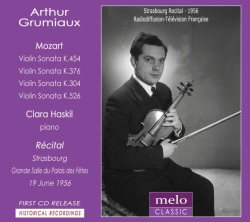|

|
Wolfgang Amadeus MOZART (1756-1791)
Sonata in B major, KV 454 (1784) [21:57]
Sonata in F major, KV 376 (1781) [15:23]
Sonata in E minor, KV 304 (1778) [10:45]
Sonata in A major, KV 526 (1787) [19:38]
Ludwig van BEETHOVEN (1770-1827)
Violin Sonata No.3 in E flat, Op.12 No.3: II Adagio (1797-98) [6:29]
Arthur Grumiaux (violin)
Clara Haskil (piano)
rec. June 1956, Strasbourg, Grande Salle du Palais des Fêtes
MELOCLASSIC MC2000 [74:15]
Arthur Grumiaux and Clara Haskil formed their duo partnership in Prades in 1953 and it was to last until the pianist’s death in 1960. These few years produced a lasting legacy, and much was recorded, either in the studio or via concert broadcasts and tapes. Three years after their first performances together the duo visited Strasbourg, in June 1956, to play an all-Mozart sonata programme which was fortunately recorded by Radiodiffusion-Télévision Française.
This was around the time that they made the first of their celebrated Mozart Sonata recordings for Philips, for whom Grumiaux made most of his discs. The composer was pretty much central to their repertoire and time and again in these live Strasbourg performances one feels the nature of their rapport, both with each other and also with the composer’s aesthetic. Grumiaux had attempted to record the sonata in B flat major, K.454 back in 1946 in London, with Gerald Moore but no recording appeared. A decade later his Philips LP did appear and this live Strasbourg performance reveals the same sure stylistic unity, the flighted elegance of the first movement Allegro section, and the refined purity of the slow movement. The deftly articulated finale pulses with intelligence and perfect weight. Their live Besançon Festival traversal, made the following year, is very similar. I’m not too familiar with the violinist’s late cycle with Walter Klien, again made for Philips, dating from 1981. Grumiaux was always conscientious about balancing subsidiary and counter-themes, which he does in a markedly thoughtful way, and is a model of grace and lyrical elegance; Haskil is his equal in those respects.
Grumiaux’s early LPs for Boston Records have resurfaced of late on Parnassus, and you can find his take on Mozart’s Sonata in E minor, K.304, accompanied by Gregory Tucker, on PACD96028. This most concise two-movement sonata exudes youthful spirit in this Strasbourg performance, and is graced by deft bowing throughout. Again, examples exist from Besançon, and from those two Philips LPs, Haskil in 1958 and Klien in 1981. The A major Sonata features one of the disc’s highlights – some exquisite phrasing in the Andante, which fully shows why this duo was one of the world’s most sympathetic interpreters of this repertoire, fully deserving to stand beside those pre-war Mozart discs by Szymon Goldberg and Lili Kraus. As an encore Grumiaux and Haskil play a single movement, appropriately the slow one, from Beethoven’s E flat major sonata, Op.12 No.3 – another of their greatest strengths.
It ends the disc in appropriate lyric gravity, and ensures that this splendidly preserved recital will take its rightful place in the pantheon of this duo’s most authoritative and sensitive live performances.
Jonathan Woolf
 |
 |
|
